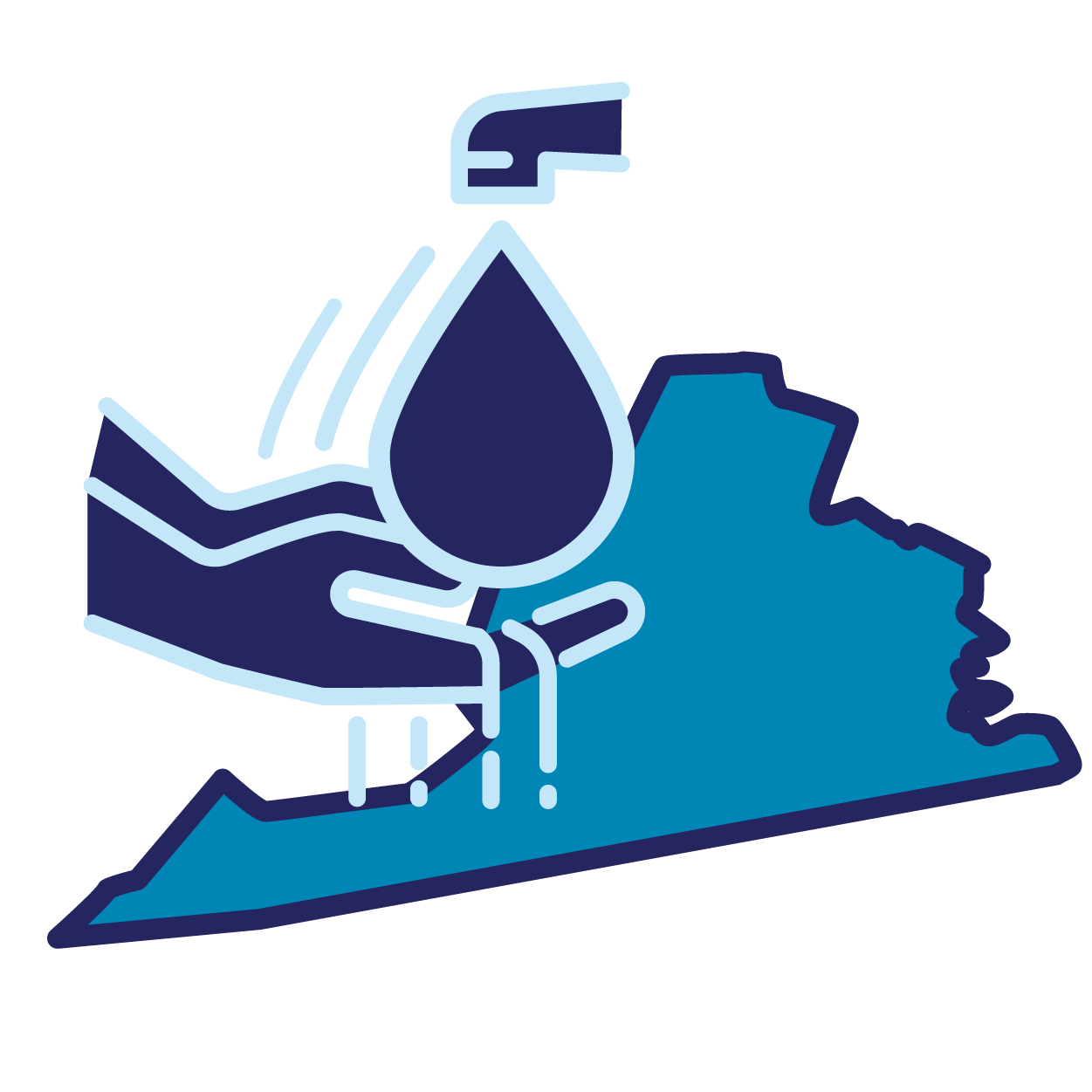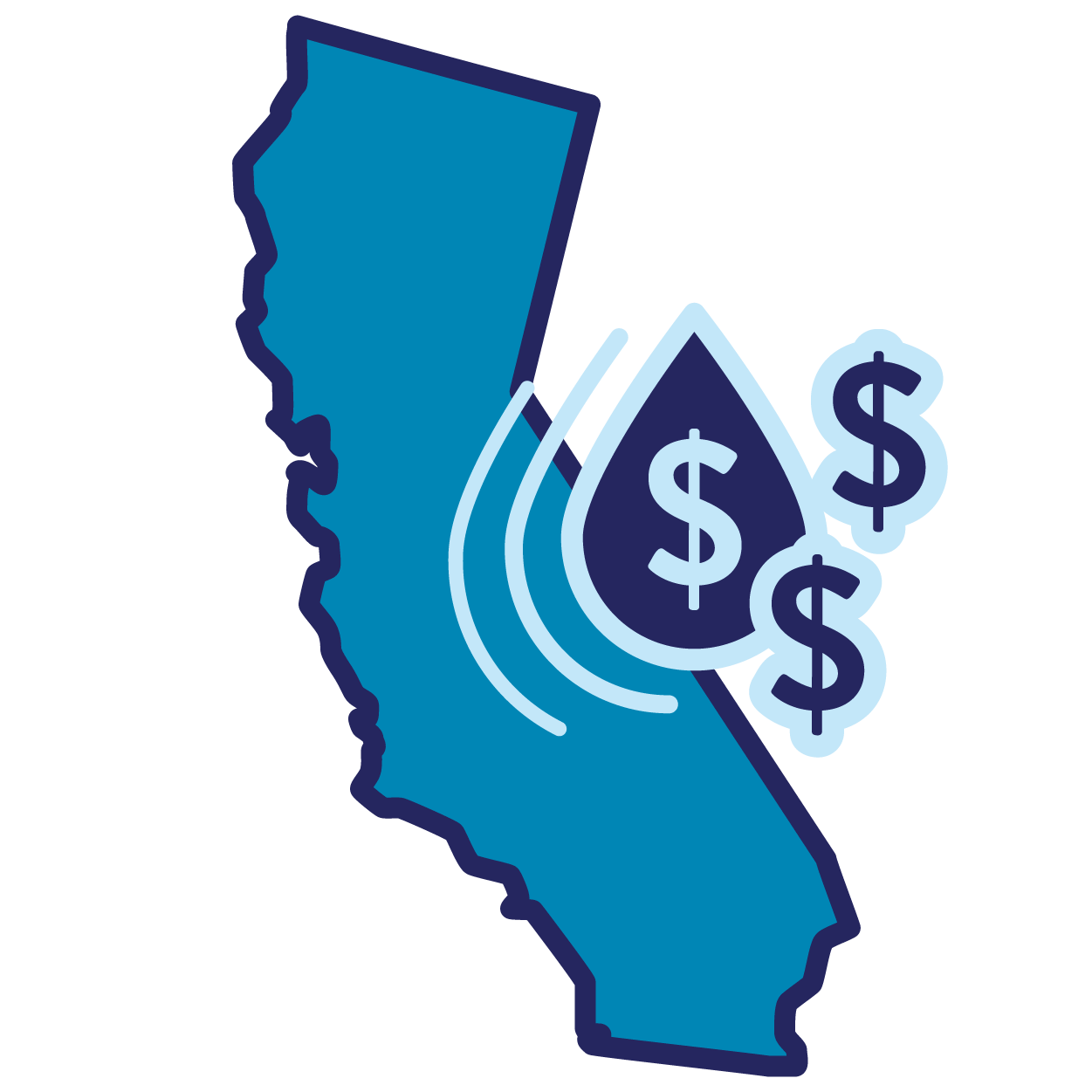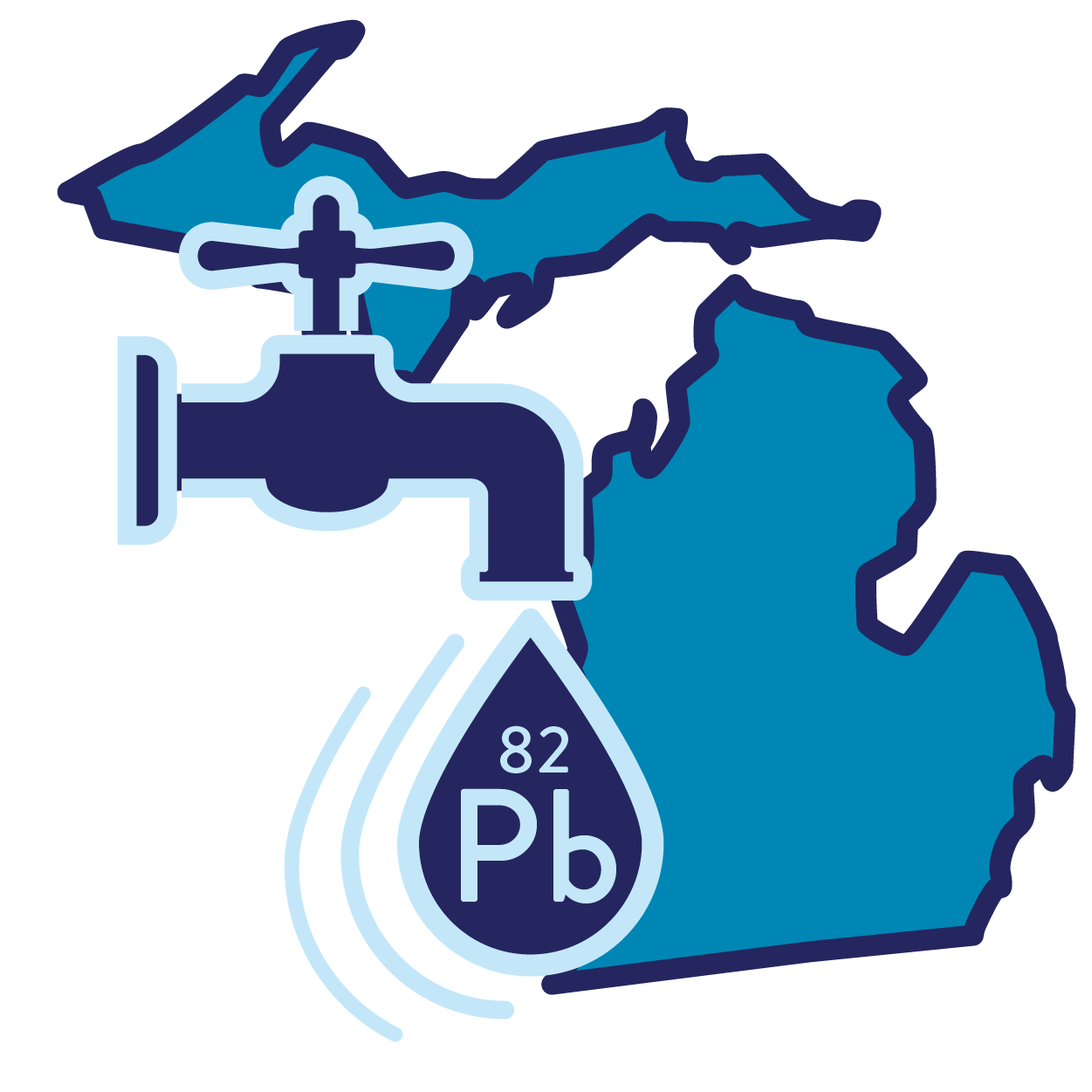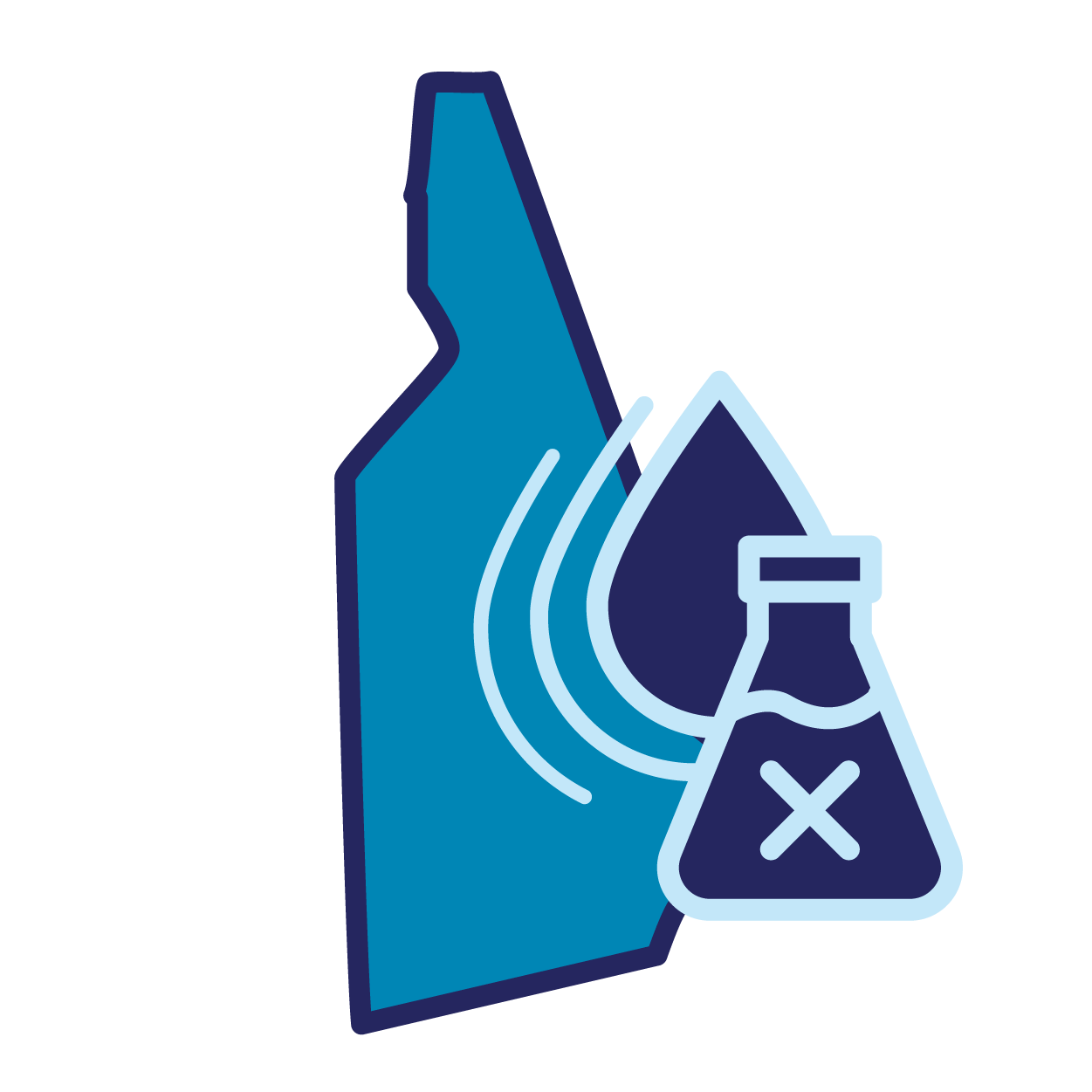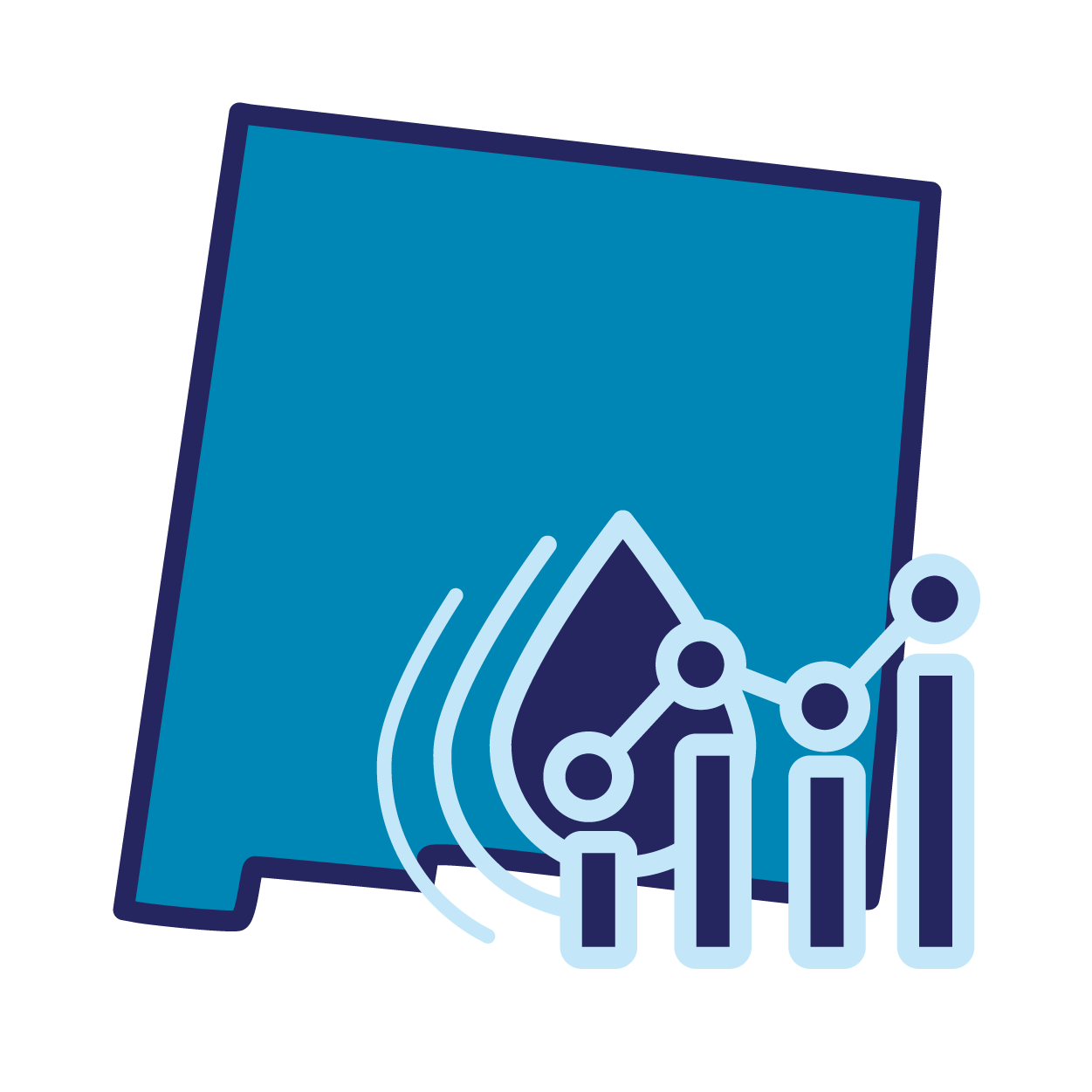State Action on Drinking Water
The Drinking Water section of the State Policy Hub currently highlights policies, resolutions, and plans related to drinking water focus areas: Access, Affordability, Lead, PFAS, and Regionalization & Consolidation.
In the Hub you’ll find:
- Overviews of each major topic: check out the buttons to the right
- Snapshots of exemplary policies by state: click the state names in the Policy Database at the bottom of this page
- Deep dives highlighting advocacy strategies, victories, and specific policy language: look for the state icons below and throughout the Hub
- Relevant lessons from network leaders: see the buttons below
Explore Drinking Water Topics
Do you know of a policy we should include? Click here to share!
Deep Dives
Select a state icon below to go deeper into specific advocacy strategies, victories, and specific policy language.
Lessons from the Network
Click the buttons below to read full-length interviews with the water leaders behind some of the exemplary drinking water policies featured in the Hub.
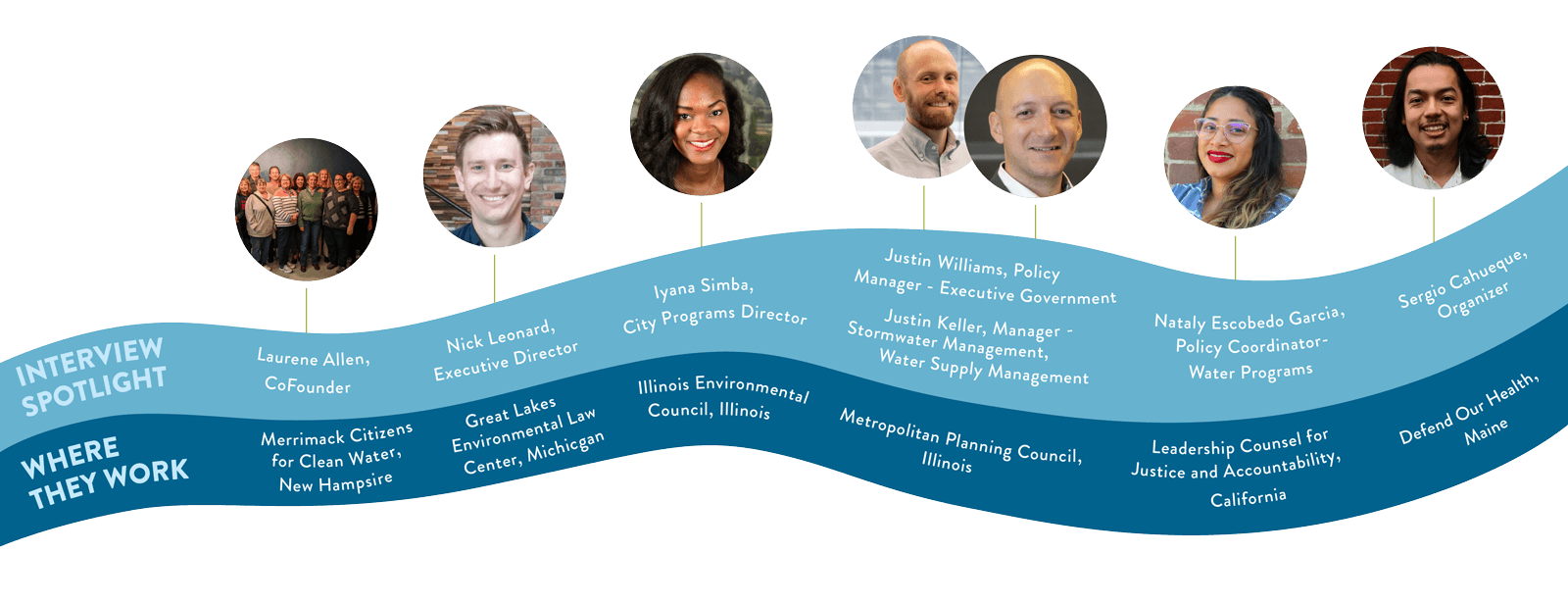
Drinking Water Policy Database
| Name | State | Action Agency | Policy Focus | Description |
|---|---|---|---|---|
| HB 512 | Ohio | Ohio EPA | Safety, lead, quality | "Establishes sampling, corrosion control, and individual tap action levels, more stringent public notification deadlines, higher administrative enforcement penalties, requirements for identifying |
| HB 1257 (§ 32.1-169 of the Code of Virginia) | Virginia | Virginia Department of Health | PFAS, Safety, quality | Directs the State Board of Health to adopt regulations establishing maximum contaminant levels (MCLs) in public drinking water systems for (i) perfluorooctanoic acid, perfluorooctane sulfonate, and for such other perfluoroalkyl and polyfluoroalkyl substances as the Board deems necessary... requires such MCLs to be protective of public health, including the health of vulnerable subpopulations, and to be no higher than any MCL or health advisory adopted by the U.S. Environmental Protection Agency for the same contaminant. |
| Water is a Human Right Resolution HJ 538 | Virginia | "The Commonwealth" | Access | Establishes that access to clean, potable water in amounts that will ensure an acceptable standard of living is a necessary human right. |
| House Bill 955 (Act 139) | Vermont | Agency of Natural Resources | PFAS, funding | $500,000.00 in FY 2021 for engineering and construction grants to improve public water systems to reimburse schools that operate public water systems with confirmed concentrations of PFAS exceeding 20 nanograms per liter and on a do-not-drink notice for their costs for providing bottled or bulk water |
| SB 49 (Act 21, An act relating to the regulation of polyfluoroalkyl substances in drinkingand surface waters | Vermont | Agency of Natural Resources | PFAS, Safety, quality | Sets maximum contaminant levels for PFAS in water to 20 ppb and requires landfills to treat leachate for PFAS. |
| Article 1 Section 27 of the Pennsylvania Constitution (Green Amendment) | Pennsylvania | The commonwealth | Access, quality | The constitutional amendment states that, "people have a right to clean air, pure water, and to the preservation of the natural, scenic, historic and esthetic values of the environment." |
| Oregon's 100 Year Water Vision | Oregon | Oregon Watershed Enhancement Board | Access, Safety, affordability, infrastructure, quality | Oregon's 100 year water vision "goals reflect the needs we have for water, our principles guide how people can work together to achieve a secure, safe and resilient water future for all who live here." |
| H2Ohio Plan | Ohio | The Governor, Ohio Department of Agriculture, Ohio Department of Natural Resources, Ohio Environmental Protection Agency, the Lake Erie Commission | Safety, infrastructure, quality | H2Ohio: A data-driven water quality plan to reduce harmful algal blooms, improve wastewater infrastructure, and prevent lead contamination. |
| House Bill 166 (Creates FY 2020-2021 operating budget) | Ohio | Department of Agriculture, OH EPA | Safety, infrastructure, quality | H2Ohio was first funded by the Ohio General Assembly with an investment of $172 million in the 2020-2021 biennium. |
| Control of lead and copper - lead service line requirements (Ohio Administrative Code, Rule 3745-81-84) | Ohio | Ohio EPA | Safety, lead | Updated state Lead and Copper Rule. |
| Senate Bill 6416 | Washington | public utility districts | affordability | Permits utility service rates to be reduced for low-income senior citizens and other low income citizens, and gives the authority of defining those groups by the governing body of the county, city, town, public utility district or other municipal corporation. |
| House Bill 1087 Water/Wastewater Public Enterprise Reform | North Carolina | State Water Infrastructure Authority | Access, Safety, infrastructure funding | Established "Viable Utility Reserve" to provide grants to struggling local governments to improve water system infrastructure. Created a process for merger and dissolution of water and wastewater systems. |
| North Carolina’s Statewide Water and Wastewater Infrastructure Master Plan: The Road to Viability | North Carolina | State Water Infrastructure Authority | funding, infrastructure, planning | SWIA created the plan for owners and operators of water and wastewater utilities and systems that serve the public, focused on organizational, infrastructure, and financial management. |
| Current Operations and Capital Improvements Appropriations Act of 2015 (HB 97) | North Carolina | Department of Environment and Natural Resources Division of Water Infrastructure for the Clean Water State Revolving Fund Wastewater Reserve and Drinking Water Reserve | Regionalization & Consolidation, affordability, consolidation, funding, regionalization | Defined "affordability" in statute to prioritize communities based on factors such as poverty rate, population change. Established merger/regionalization feasibility grants for consolidation of water or wastewater systems. |
| General Statute 159G-70 | North Carolina | State Water Infrastructure Authority (within the Department of Environment and Natural Resources) | infrastructure funding, planning | Created the State Water Infrastructure Authority to develop a state water infrastructure master plan and award funding for water and wastewater infrastructure projects. |
| Volume A (Title 10) Part 5 Subpart 5-1 Public Water Systems; Maximum Contaminant Levels' Monitoring requirements' notification requirements | New York | Department of Health | PFAS, Safety | In 2020, the state adopted new drinking water standards addressing PFOA, PFOS, and 1,4 Dioxane, implementing maximum contamination levels of 10 ppb (1 ppb for Dioxane) and public water systems must monitor, report, and address contamination to reduce exposure. |
| Senate Bill S8158 | New York | Department of Health, State Department of Education | Safety, quality | Requires school districts and boards of cooperative educational services to conduct periodic testing to monitor for lead contamination in certain school buildings; provides additional aid to such districts and boards for the costs incurred due to the testing of potable water sources and systems containing an unacceptable amount of lead. |
| Senate Bill 968/A2863 | New Jersey | public water systems, landlords implement, NJ Department of Community Affairs | Safety, quality | Requires public water systems to provide notice of elevated lead levels in drinking water to customers and local officials; requires landlords to notify tenants of elevated lead levels. |
| Safe Drinking Water Act Rules, N.J.A.C. 7:10, Private Well Testing Act Rules, N.J.A.C. 7:9E, Ground Water Quality Standards, N.J.A.C 7:9C,... N.J.A.C. 7:1E, MCLs, GWQS, and Related Requirements for PFOA and PFOS | New Jersey | New Jersey Department of Environmental Protection, Water Resources Management Division of Water Supply and Geoscience | PFAS, Safety, quality | Set an MCL of 14 ppt for PFOA and 13 ppt for PFOS in drinking water. The MCLs apply to public community and public noncommunity water systems. Sections 1 and 2 took effect 9/8/2018. |
| Water Quality Accountability Act (N.J.S.A. 58:31-1) | New Jersey | New Jersey Department of Environmental Protection (NJDEP) central role in its implementation, along with New Jersey Board of Public Utilities, New Jersey Office of Homeland Security and Preparedness, and the New Jersey Department of Community Affairs; water purveyors are those who are affected by the act. | Safety, quality | Established requirements to improve safety, reliability, and administrative oversight of water infrastructure, such as routine maintenance of pumps, motors, and pipes by public water system managers. |
| House Bill 22-1358 | Colorado | Colorado Department of Public Health and Environment | lead, lead testing in schools | Created a requirement for child care centers, family child care homes, and PK-5th grade public schools to test for lead in their drinking water sources. Results and any remediation plans must have been made publicly available online. |
| Senate Bill 5512 | New York | New York State Department of Health | lead, lead service lines | Outlines a plan and requirements for covered water systems throughout New York state to inventory for lead service lines and make that information publicly available. The Department of Health will illustrate this data for large systems in interactive maps online. |
| Senate Bill 1 | New Mexico | New Mexico State Engineer & Secretary of State | Regionalization & Consolidation, regionalization | Streamlines the process of regionalizing water and wastewater public utilities in New Mexico. Intended to allow for smaller utilities to regionalize and benefit from economies of scale. |
| House File 2310 | Minnesota | Minnesota Pollution Control Agency | PFAS, funding | Creates and progresses a variety of methods to mitigate per- and polyfluoroalkyl substances (PFAS) in Minnesota, including appropriating funds for grant programs and other initiatives. |
| Senate Bill 2298 | Rhode Island | Rhode Island Department of Health | PFAS, quality | Authorizes the establishment of maximum contaminate levels of per- and polyfluoroalkyl substances (PFAS) in drinking water systems, as well as interim standards and testing requirements, new groundwater and surface water standards, investigation of PFAS sources, and landfill monitoring. |
| Senate Bill 0724, Section 1 | Rhode Island | Rhode Island Department of Health | PFAS | Amends the law to require public water systems in exceedance of interim drinking water standards for PFAS to enter into a consent agreement with the Rhode Island Department of Environmental Management. |
| Senate Bill 88 | Michigan | Michigan Department of Licensing and Regulatory Affairs & Department of Environment, Great Lakes, and Energy | Safety, lead, lead testing in schools | Requires child care centers to create and maintain drinking water management plans that include filtered water outlets to mitigate exposure to lead in drinking water. Testing of filtered water must occur at least every 2 years. |
| House Bill 4342 | Michigan | Michigan Department of Licensing and Regulatory Affairs & Department of Environment, Great Lakes, and Energy | Safety, lead, lead testing in schools | Provides additional standards for child care centers to mitigate exposure to lead contamination in drinking water. The act includes what assistance and trainings will be available from the MI Department of Licensing and Regulatory Affairs and the Department of Environment, Great Lakes, and Energy. |
| House Bill 4341 | Michigan | Michigan Department of Environment, Great Lakes, and Energy | Safety, lead, lead testing in schools | Directs schools to create drinking water management plans with filtered water stations, along with annual testing for lead contamination in those drinking water outlets. Creates a clean drinking water fund to support schools with the implementation of the program. |
| House File 24 | Minnesota | Public Facilities Authority, Minnesota Department of Health | lead, workforce development | Created a funded grant program to replace lead service lines in Minnesota, with the goal of replacing all lead service lines in the state by 2033 and to ensure that lead service line inventory data is accessible to the public. Workforce development: |
| HB 1264 | New Hampshire | Department of Environmental Services | PFAS, Safety, quality | Sets the maximum contaminant levels for certain perfluorochemicals in drinking water, establishes a PFAS fund and programs and makes an appropriation requiring insurance coverage for PFAS and PFC blood tests, and expands the statute governing ambient groundwater quality standards. Sections 12 and 14 took effect January 1, 2021, Sections 9, 10, 11 and 13 took effect September 21, 2020. Remainder took effect July 23, 2020) |
| Constitution of the State of New York, Article 1, Section 19 | New York | State of New York | Access, environmental rights | The New York state constitution has what is known as a “Green Amendment.” In Article 1, Section 19, it states “Each person shall have a right to clean air and water, and a healthful environment.” It was added by vote of the people in November, 2022. |
| House Bill 1138 | Indiana | Indiana Finance Authority and Indiana Department of Environmental Management | lead, lead testing in schools | Requires preschools and child care facilities to test for the presence of lead in drinking water and remediate the contamination if it equals or exceeds the action level of 15ppb. |
| SB 403 | California | California State Water Resources Control Board | Infrastructure consolidation, Regionalization & Consolidation, consolidation | This act details how consolidation of water services may be required for communities to ensure that disadvantaged communities have access to an adequate supply of safe drinking water after voluntary measures have been attempted. Public participation and engagement is also detailed in the bill language. |
| SB 994/AB 3329 | New Jersey | Board of Public Utilities, Department of Community Affairs | affordability, water shutoffs | This legislation requires the Board of Public Utilities (BPU) to collect data on consumers' ability to afford utility bills, including water and sewer bills, and the extent of water shutoffs due to non-payment. Utilities (both private and publicly owned) must share monthly data on rates, the number of customer disconnection notes sent due to bill non-payment, service disconnections due to bill non-payment, service reconnections of customers disconnected for bill non-payment, average time between service disconnection due to non-payment and service reconnection, and a number of other reporting requirements. |
| Water policy: environmental justice & disadvantaged and tribal communities (AB 2108) | California | State Water Resources Control Board | civic engagement in planning processes, planning, quality | This act amends California's Water Code, directing the State Water Resources Control Board and each regional board to conduct outreach to identify issues of environmental justice as early as possible in planning, policy, and permitting processes. The boards must "engage in equitable, culturally relevant community outreach to promote meaningful civic engagement from potentially impacted communities of proposed discharges of waste that may have disproportionate impacts on water quality in disadvantaged communities or tribal communities and ensure that outreach and engagement shall continue throughout the waste discharge planning, policy, and permitting processes." Pending funding, coordinators from environmental justice and tribal communities will be hired to support this work, and the State Board will establish a community capacity-building stipend program to increase meaningful civic engagement by disadvantaged communities and tribal communities. |
| Perfluoroalkyl and Polyfluoroalkyl Chemicals Consumer Protection Act (HB 22-1345) | Colorado | PFAS, Safety | This bill restricts the sale of PFAS in a long list of consumer products, requires labeling of products containing PFAS, and restricts the sale of fluids used in the extraction of oil and gas products starting in 2024. |
|
| Senate Bill 48 | Wisconsin | Public Service Commission | Safety, infrastructure, lead service lines | Clarifies the ability to financially assist and replace consumer-owned portions of lead service line replacement by water utilities. |
| Pollution Prevention for Healthy People and Puget Sound Act (Senate Bill 5135) | Washington | Department of EcologyDepartment of Health | PFAS, Safety | This legislation does not apply directly to drinking water, but instead creates a process for the Department of Ecology to identify chemicals of concern, as well as consumer products that contain chemicals of concern, to determine regulatory actions. The initial list includes PFAS. |
| Senate Bill 6413 | Washington | Department of Ecology | PFAS, Safety | This legislation does not apply directly to drinking water, but instead focuses on sources of PFAS, including firefighting foam and firefighting personal protection equipment. Starting in 2020, the manufacturing or sale of PFAS-based firefighting foams is prohibited in the state. |
| Assembly Bill 508 | California | State Water Resources Control Board | Regionalization & Consolidation, Safety, access (consolidation), consolidation, quality | Requires the State Water Resources Control Board to inform the public of consolidation processes (physical or operational). Disadvantaged communities who rely on failing domestic wells can petition for consolidation to the state board. The bill provides clear timelines for the consolidation process. |
| Clean Water for Delaware Act (HB 200) | Delaware | Clean Water Trust Oversight Committee, Water Infrastructure Advisory Council, (WIAC), the county Conservation Districts’, experts in the affected Cabinet agencies | Safety, infrastructure, infrastructure funding, quality | Amends the Delaware code to designate a Delaware Clean Water Trust account to ensure the greatest environmental return on investment through the management and coordination of financial resources available to the State for drinking water, wastewater, drainage, stormwater, and other eligible clean water projects. |
| Water Pollution Control Authorities (Substitute House Bill No. 5509/Act No. 18-174) | Connecticut | Public Utilities Regulatory Authority | Access, water shutoffs | Protects against foreclosures by private water companies of certain populations due to past due sewer fees and lowers the interest rate charged on delinquent assessments. |
| Executive Order 66 | Connecticut | Water Planning Council (Public Utilities Regulatory Authority, Office of Policy and Management, and Department of Energy and Environmental Protection, and the Department of Public Health) | Access, infrastructure, quality | Outlines the Water Planning Council’s ability to implement the State Water Plan to manage water resources, identifies water as a public trust. |
| Senate Bill 837 (Public Act No. 21-191) | Connecticut | Commissioner of Energy and Environmental Protection | PFAS, Safety | Prohibits the use of class B firefighting foam that contains an intentionally added perfluoroalkyl or polyfluoroalkyl substance. |
| House Bill 20-1119 | Colorado | Solid and Hazardous Waste Commission, Department of Public Health and Environment | PFAS, Safety | Bans the use of class B firefighting foams that contain PFAS in come aircraft hangars, requires the Solid and Hazardous Waste Commission to promulgate rules to register facilities that use and store PFAS. |
| Senate Bill 20-218 | Colorado | Department of Public Health and Environment | PFAS, Safety, quality | Created a funding mechanism through charging per truckload of fuel products within the state to address PFAS contamination through a grant program, takeback program, and providing technical assistance. |
| Safe Water in Schools Act (House Bill 1306) | Colorado | Department of Public Health and Environment | Safety, lead | Established a grant program to test for lead in drinking water in public schools, with primary focus on elementary schools. |
| California's Water Resilience Portfolio 2020 | California | The California Natural Resources Agency, the California Environmental Protection Agency, the California Department of Food and Agriculture, in consultation with the Department of Finance | Access, Safety, affordability, infrastructure, quality | Developed in response to Executive Order N-10-19. Goals and actions are organized in four categories: |
| Executive Order N-10-19 | California | The California Natural Resources Agency, the California EnvironmentalProtection Agency, the California Department of Food and Agriculture, inconsultation with the Department of Finance | Access, Safety, affordability, infrastructure, quality | Directed applicable agencies to develop a Water Resilience Portfolio for the 21st century. |
| Hawaii Constitution Article 11 Section 9 Environmental Rights | Hawaii | The state | Access, quality | "Each person has the right to a clean and healthful environment, as defined by laws relating to environmental quality, including control of pollution and conservation, protection and enhancement of natural resources. Any person may enforce this right against any party..." |
| Safe and Affordable Drinking Water (SADW) Fund: Safe and Affordable Funding for Equity and Resilience (SAFER) Program (SB 200) | California | State Water Resources Control Board, State Treasury | Funding for small systems | Established the Safe and Affordable Drinking Water Fund. Provides up to $130 million for the next 10 years to help water systems provide safe and affordable drinking water. |
| Assembly Bill 72 | California | State Water Resources Control Board | Safety, funding, lead testing in schools | Provided 5 million dollars to test for and remediate lead exposure in childcare centers. |
| Water Shutoff Protection Act (SB 998) | California | Urban and Community Water Systems implements. | Access, affordability, water shutoffs | Improved transparency in the process and timeline of informing customers of delinquent water bills and possibility of shutoffs, and blocks shutoffs from occurring if customers demonstrate that they are financially unable to pay or have a health condition that would be worsened by lack of water. |
| Senate Bill 552 | California | State Water Resources Control Board | Regionalization & Consolidation, Safety, access (consolidation), consolidation | Gave authority to the state board to extend water service to areas that lack safe drinking water as an interim extension of service prior to consolidation. |
| Low-Income Water Rate Assistance Act (Assembly Bill 401) | California | Water Quality Control Board | affordability, funding | Required the Water Quality Control Board to develop a Low-Income Water Rate Assistance Program plan by 2018. |
| Senate Bill 88 | California | State Water Resources Control Board | Regionalization & Consolidation, Safety, access (consolidation), consolidation, infrastructure | Authorized the State Water Resources Control Board to incentivize and mandate consolidation of failing water systems. |
| Human Right to Water, Water Code Section 106.3 (Assembly Bill 685) | California | All relevant state agencies, including Department of Water Resources, State Water Resources Control Board, and the State Department of Public Health | Access, Safety, affordability | Updated the Water Code of California, asserting that every human has a right to clean, safe, affordable, and accessible water. |
| Water Improvements Program (AZ SB 1459) | Arizona | County Board of Supervisors | Access, affordability | Authorized the County Board of Supervisors to establish water improvement programs that may be funded through private gifts or grants to help low-income and fixed income residents deepen existing drinking water wells or improve plumbing. |
| Small Drinking Water Systems Fund Act No. 213 (HB 2049) | Arizona | Water Infrastructure Funding Authority (WIFA) | Safety, infrastructure | Expanded grant eligibility to help small public water systems in need of water quality upgrades and infrastructure repairs. |
| Water Taxpayer Protection Act of 2019 | Maryland | City of Baltimore | Access, affordability | Limits the collector of the city of Baltimore from putting a lien on a place of worship or residential property if the only debt owed is from water and sewer charges, |
| Senate Bill 309 | New Hampshire | Department of Environmental Services | PFAS, Safety, quality | Regulates groundwater pollution caused by polluting emissions in the air and relative to standards for perfluorochemicals in drinking water, ambient groundwater, and surface water. Authorizes the Department to set maximum contaminant limits for perfluorooctanoic acid (PFOA), perfluoroctanesulfonic acid (PFOS), perfluorononanoic acid (PFNA), and perfluorohexanesulfonic acid (PFHxS). |
| Constitution of the State of Montana, Article 2, Part 2, Section 3 and Article 9, Part 9, Section 1 | Montana | The legislature | Access, quality | “The state and each person shall maintain and improve a clean and healthful environment in Montana for present and future generations. |
| HF 1 (water infrastructure bond bill) | Minnesota | Minnesota Public Facilities Authority (a multi-agency authority providing financing and technical assistance to local governments for infrastructure projects) | Safety, funding, infrastructure, quality | Increased the lending capacity of the Clean Water and Drinking Water revolving funds, providing funding for safe drinking water infrastructure upgrades and repairs as well as flood control and pollution protection. |
| Clean Water Legacy Act | Minnesota | Pollution Control Agency, Clean Water Council | funding, quality | Created the Clean Water Fund, which comes from the sales tax revenue of the Legacy amendment. The fund will help maintain water quality, improve waters that are impaired, and restore degraded groundwater. Distribution of funds include grants, loans, and technical assistance. Project priorities will be identified by a Clean Water Council |
| PFAS Drinking Water Standards Ruleset | Michigan | EGLE | Safety, quality | Adopted a ruleset limiting seven PFAS chemicals in drinking water and are more stringent than current US EPA guidance on the chemicals. |
| MI Clean Water Plan | Michigan | EGLE | Safety, funding, infrastructure, quality | The plan includes $500 million investment in the state's water infrastructure, including different types of grants. |
| Executive Order 2019-3 Department of Environmental Quality Michigan PFAS Action Response Team | Michigan | Department of Environmental Quality | Safety, quality | Established the MPART as a permanent body to address the threat of PFAS contamination in Michigan, protect public health, and facilitate inter-agency coordination, and clear standards to ensure accountability. |
| Lead and Copper Rule (revised) | Michigan | EGLE | Safety, quality | Lead action level will change from 15 to 12 parts per billion in 2025. Improved the sampling protocol for lead and copper tap sampling, and created a timeline for comprehensive, updated inventories of service lines and distribution system components. Prohibits partial lead service line replacements and requires all LSLs to be replaced within 20 years. |
| Massachusetts Constitution, Part the First, Art. XCVII. | Massachusetts | The general court | Access, Safety, environmental rights | Environmental rights section of constitution states that people have the right to clean air and water, among other environmental protections. |
| AK H 209 Water and Sewer Advisory Committee | Alaska | Legislative committee (Bush Caucus) | Access, Safety | Created the Alaska Water and Sewer Advisory Committee in the legislative branch to develop a report related to safe and sustainable water and sewer systems to all rural areas of the state. |
| An Act to Stop Perfluoroalkyl and Polyfluoroalkyl Substances Pollution (HP 113-LD 1503) | Maine | Department of Environmental Protection | PFAS, Safety | Established the first state-wide ban on the sale of products containing intentionally added PFAS, which goes into effect in 2030. An earlier deadline of 2023 will curb the use of PFAS in textiles. |
| To Protect Consumers of Public Drinking Water by Establishing Maximum Contaminant Levels for Certain Substances and Contaminants (S.P. 64-L.D. 129) | Maine | Department of Health and Human Services | PFAS, Safety | Requires water systems to monitor for PFAS contaminants, if found at 20 nanograms per liter, quarterly monitoring is required until mitigated. The DHHS will require water systems to inform the public and develop mitigation measures. On or before June 1, 2024, the department shall file a final rule with the Secretary of State regarding the regulation of regulated PFAS contaminants, establishing Maximum Contaminant Levels. Interim MCL of 20 parts per trillion went into effect. |
| SB 409 | Kentucky | Kentucky Infrastructure Authority (KIA) | Infrastructure consolidation, Regionalization & Consolidation, Safety, consolidation, quality | Created county 2020 water management planning councils, who made long term water supply plans. Funding required to assist in making potable water available to all Kentuckians by 2020. KIA established an incentive program that allocates funds from the 2020 water service account to encourage the regionalization, merger, and |
| Illinois Constitution, Article 11, Section 2 | Illinois | Legislative responsibility | Access, environmental rights, quality | "Each person has the right to a healthful environment. Each person may enforce this right against any party, governmental or private, through appropriate legal proceedings subject to reasonable limitation and regulation as the General Assembly may provide by law." |
| Senate Bill 550 | Illinois | Illinois Environmental Protection Agency, school districts, community water systems | Safety, lead testing in schools, quality | Amended the Illinois Municipal Code to establish a lead hazard cost recovery fee to water customers that utilities are allowed to impose to cover costs for lead remediation. Also requires testing for lead in schools and notification sent to parents if over 5 ppb. Requires the owners |
| Clean Water Workforce Pipeline Program (SB 2146, Act No. 576) | Illinois | Department of Commerce and Economic Opportunity, with coordination from Illinois Environmental Protection Agency, Illinois Finance Authority, and "other State agencies that provide financial support for water infrastructure projects." | infrastructure, quality, workforce development | This Act created a program with funding specifically focused on training marginalized/disadvantaged residents to enable them to contribute to clean water infrastructure projects in the state. |
| Lead Service Line Replacement and Notification Act (HB 3739) | Illinois | Illinois Environmental Protection Agency, Department of Commerce and Economic Opportunity, Illinois Commerce Commission | Safety, affordability, infrastructure, lead service lines | The Act bans partial lead service line replacement, creates a timeline for when all lead service lines will be replaced by, develops a progressive fund to allocate money for infrastructure projects. Funding will come from billed water usage based on census tract median household income, prioritizing the removal of LSLs in low-income communities where LSLs are most prevalent. |
| Water and Sewer Financial Assistance Act (HB 0414) | Illinois | Department of Commerce and Economic Opportunity | Access, affordability | Established a low-income water and sewer assistance payment program, prioritizing low-income households with the highest water burden, as well as those over 60, with additional priority to households with children and people with disabilities. The Act created the Water and Sewer Low-income Assistance Fund in the State Treasury, primarily funded through a charge imposed on customers by participating water and sewer providers. |


